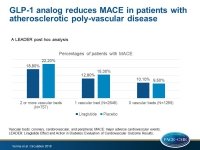GLP-1 analog reduces major CV outcomes in patients with atherosclerotic poly-vascular disease
Patients with T2DM and atherosclerotic poly-vascular disease have a higher CV risk than patients with single vascular disease, and in both groups liraglutide consistently reduced major CV outcomes.
Effect of Liraglutide on Cardiovascular Events in Patients With Type 2 Diabetes Mellitus and Polyvascular Disease. Results of the LEADER TrialLiterature - Verma S, Bhatt DL, Bain SC, et al. - Circulation 2018;137:2179–2183
Introduction and methods
In the LEADER (Liraglutide Effect and Action in Diabetes: Evaluation of Cardiovascular Outcome Results) trial, the GLP-1 analog liraglutide reduced CV events in patients with type 2 diabetes mellitus (T2DM) at high CV risk [1].
In this post hoc analysis of LEADER, the effects of liraglutide were assessed in patients with or without atherosclerotic poly-vascular disease in more than 1 vascular bed (coronary, cerebrovascular, and peripheral).
LEADER was a randomized trial of liraglutide (1.8 mg or maximum tolerated dose) versus placebo in 9,340 patients with T2DM and high CV risk (median follow-up: 3.8 years). The primary outcome was MACE, a composite of CV death, nonfatal myocardial infarction, or nonfatal stroke. The key secondary outcome (expanded MACE) also included hospitalization for unstable angina, coronary revascularization, or hospitalization for heart failure.
Main results
- Patients with poly-vascular disease had a higher risk of CV outcomes compared with those with single vascular disease (HR for MACE: 1.52; 95%CI: 1.33–1.73; HR for expanded MACE: 1.45; 95%CI: 1.31–1.62; HR for CV death: 1.41; 95%CI: 1.13–1.75).
- Liraglutide reduced MACE consistently in patients with poly-vascular disease (HR: 0.82; 95%CI: 0.66-1.02) and with single vascular disease (HR: 0.82; 95%CI: 0.71–0.95). Results were similar for expanded MACE and CV death.
- The risk reduction in MACE and expanded MACE in patients with single and poly-vascular disease was similar to that of the total trial population in LEADER.
- In patients without atherosclerotic CVD at baseline, the HR for liraglutide versus placebo for MACE was 1.08 (95%CI: 0.84–1.38), with similar results for expanded MACE and CV death.
- No significant interaction was found among risk groups, except for expanded MACE (P=0.03), This latter finding might be driven by the group of patients without atherosclerotic CVD.
Conclusion
In patients with T2DM and documented atherosclerotic CVD, the presence of poly-vascular disease was associated with a higher CV risk compared with single vascular disease patients. Liraglutide consistently reduced major CV outcomes in both groups.
References
1. Marso SP, Daniels GH, Brown-Frandsen K, et al, LEADER Steering Committee, LEADER Trial Investigators. Liraglutide and cardiovascular outcomes in type 2 diabetes. N Engl J Med.2016;375:311–322.

